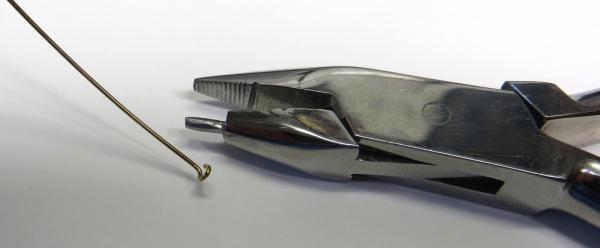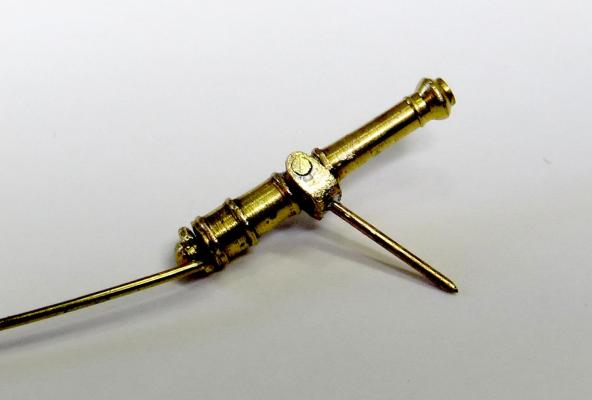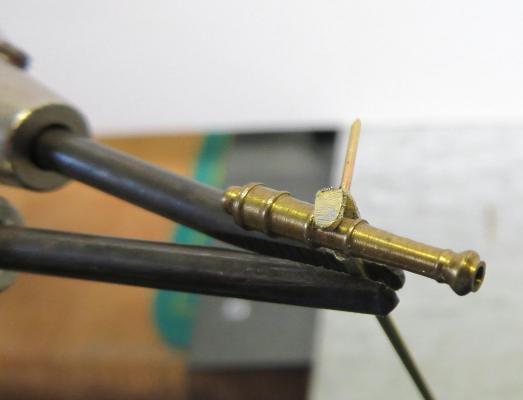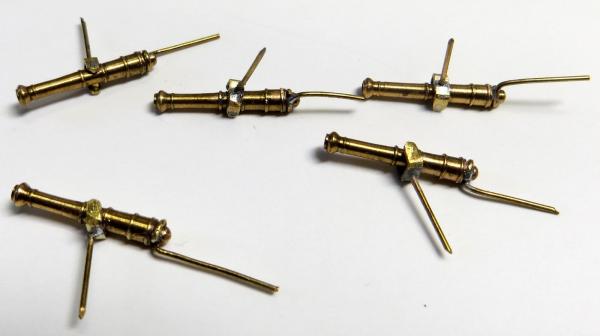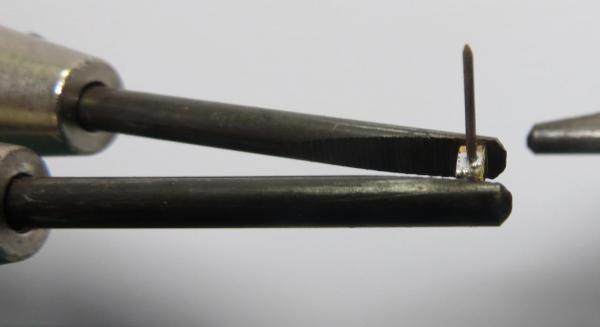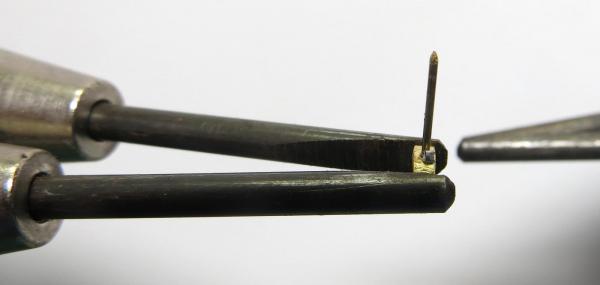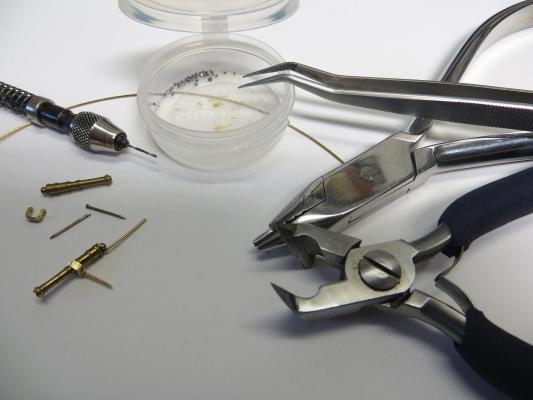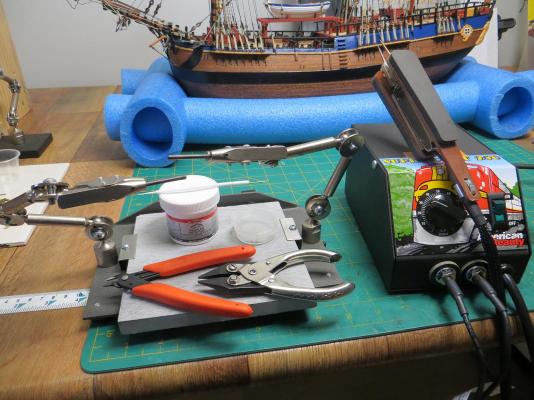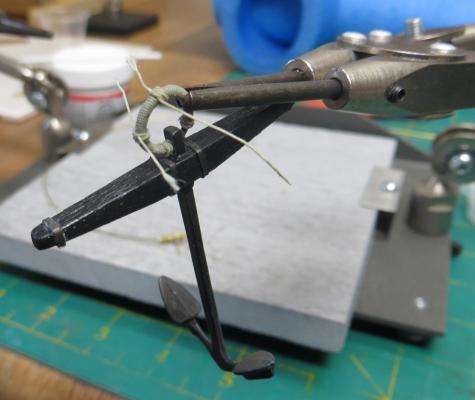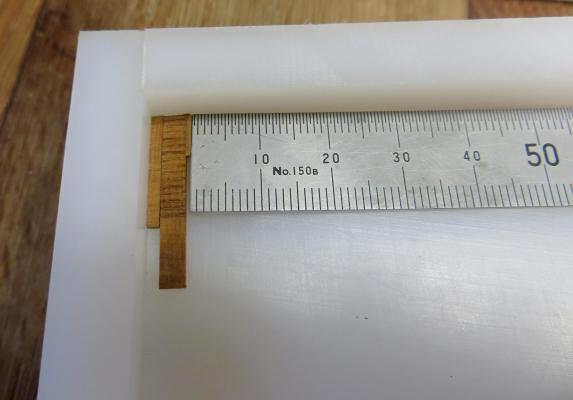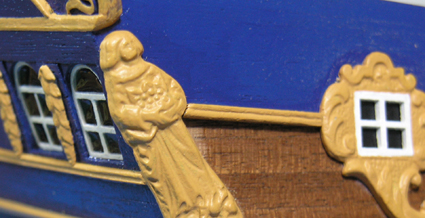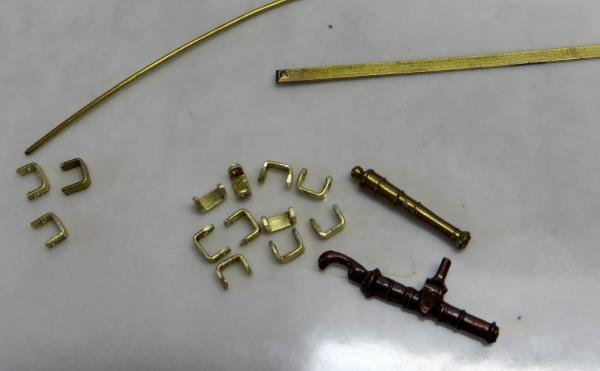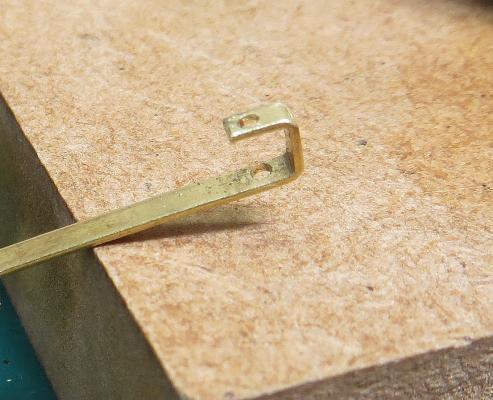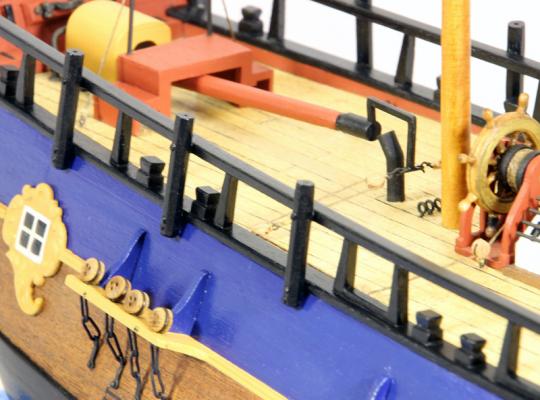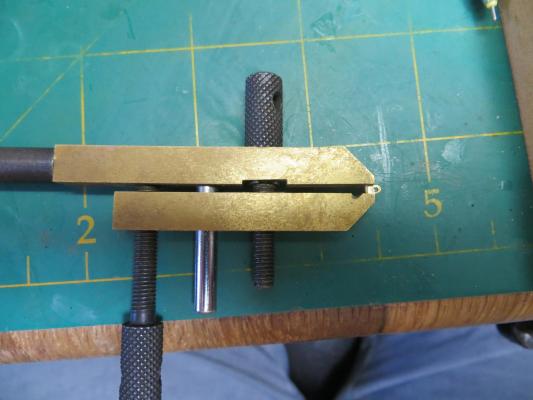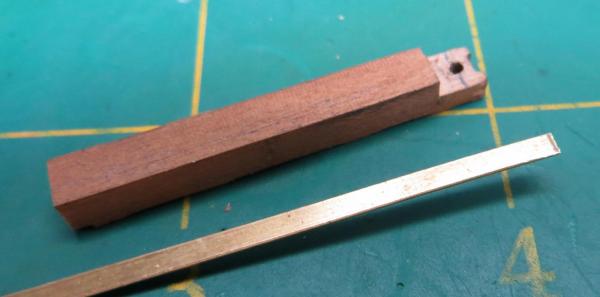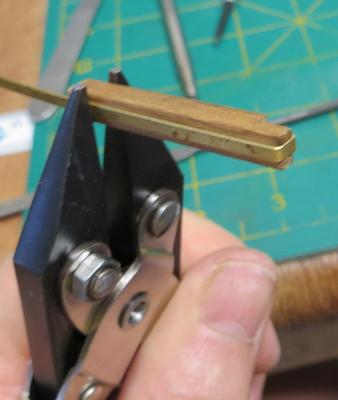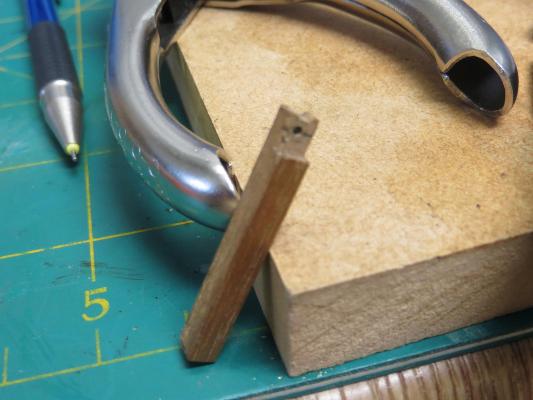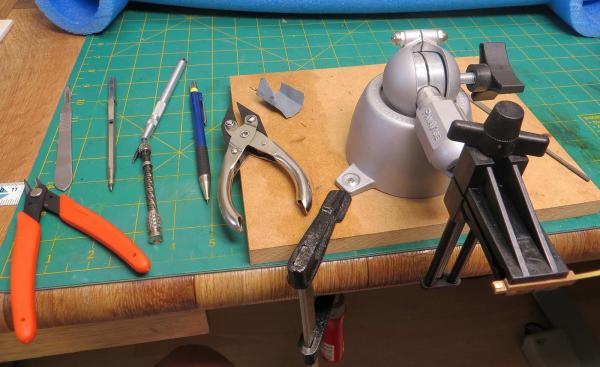-
Posts
5,951 -
Joined
-
Last visited
Content Type
Profiles
Forums
Gallery
Events
Everything posted by BANYAN
-
Thanks all for looking in and kind comments. John, yep - that is the downside as it does cost significantly more to set up. But I would argue that if doing a lot of soldering, and some of that may be on or very near the model at times (fixing breakages etc ) then it is still a WHOLE lot cheaper than rebuying/redoing the model if it catches fire The real advantage though is that I can do several different joints in very close proximity without de-soldering the others to get a new one ion place. if you can afford it, I would very highly recommend it. cheers Pat [Edit: I should have been a little clearer that the gun barrels are after-market - these are some of Chuck's excellent products.]
- 517 replies
-
- Endeavour
- Artesania Latina
-
(and 1 more)
Tagged with:
-
Part 2 of the Swivel gun assembly process with some partially completed units in the last photo. I still need to clean these up, blacken them and add the control arm knob/timber (not sure which way to go yet). I am also looking foe pointers/advice on what to use or how to create a fixed circular pate about half the way down the spigot that would sit on the gun post and stop the spigot going further down the hole. This then allowed to gun to rotate in the hole. This will require a very small washer type part to be soldered in place which at about 1.5mm may be a tad small to achieve cheers Pat
- 517 replies
-
- Endeavour
- Artesania Latina
-
(and 1 more)
Tagged with:
-
Part 1 of the Swivel Gun production line These show my soldering set-up and some of the tools I use. Also the first stages in preparing and soldering the cradle for the gun - one photo shows the part in place with flux applied and bead of solder ready to for the heat. As you can see a relatively clean joint with minimal clean-up required. Please note the part is only 1.25mm x 4mm long x 3mm high. I have moved to Resistence Soldering as it enables me to really control the soldering heat and restrict the area that is intensely heated for the solder to flow. The anchor ring above was soldered in-situ with the puddenning in place with no problems. this will also allow me to solder chains, plates etc on the model if required; but some care is still required. A lot better than putting a naked flame anywhere near these materials. cheers Pat
- 517 replies
-
- Endeavour
- Artesania Latina
-
(and 1 more)
Tagged with:
-
- 517 replies
-
- Endeavour
- Artesania Latina
-
(and 1 more)
Tagged with:
-
The stern is coming along nicely Mark; keep practising the leaves - you'll get there. Is it a trick of the light or have your treated the window glazing to create an internal candle glow effect? Looks great in the photo. cheers Pat
-
Very nice work Dan, that is 'first class' work mate. cheers Pat
- 268 replies
-
That's a major milestome mate; as you say - one that is good to see the backside of Hope there are no follow-on major tremors to cause further concern. cheers Pat
-
Thanks Steve, that explains a lot. Just looking at your pics explained it straight away - the windows were angled and not square as per AL model and hence would swing as indicated/drawn. I wish I had noticed this earlier (much earlier) I will just have to live with it as removing these runs a serious risk of disturbing the second layer (veneer) hull planking - bugger! Sorry to disappoint Greg Thanks for the feed back Steve and Greg, I will have to pay a lot more attention to these sorts of details much earlier in my next builds. At least the Vampire and HMCSS Victoria did not have these so one less thing to stress about. cheers Pat
- 517 replies
-
- Endeavour
- Artesania Latina
-
(and 1 more)
Tagged with:
-
Thanks Greg, I'll stay with flat then Makes you woonder though, that if you had to do all that work to get the 'jaunty' offset angles whether it was the actual practice? cheers Pat
- 517 replies
-
- Endeavour
- Artesania Latina
-
(and 1 more)
Tagged with:
-
Great story Chris, thanks for sharing. We also have an elderly member of our club whom served on the Pamir (when a Kiwi ship) for part of WWII - he has some interesting stories including rounding the horn. Not many of these 'salts' left now for whom the old saying is appropriate " when ships were made of wood and the men of steel" cheers Pat
-
Thanks for the photos Greg and for looking in. I know that like a gate, it sometimes sits at an awkward angle when open, but flat/parallel to the surface when closed. But I am yet to be convinced this window was rounded and required such treatment. That said though, if the replica has these, and they do appear to be working versions, I may have to reconsider? cheers Pat
- 517 replies
-
- Endeavour
- Artesania Latina
-
(and 1 more)
Tagged with:
-
Thanks Chris, you'll improve your skills as you go mate and end up showing me (and others) some new tricks also cheers Pat
- 517 replies
-
- Endeavour
- Artesania Latina
-
(and 1 more)
Tagged with:
-
And now for the start of the quarter badge windows. These are only 0.75mm thick and just over 5mm wide. I have attempted to show the louvers by inscribing on both sides then preshading before painting them red. these will be positioned in the open position. The AOTS and some drawings show these as angles up on one side and down on the other but I believe this to be incorrect. the angled positioning would be justified if the badge windows were in a rounded housing/gallery, but these windows (on Endeavour) are relatively flat and would there for open outward flat or 90 degrees to the plane of the window. Open to discussion here please cheers Pat
- 517 replies
-
- Endeavour
- Artesania Latina
-
(and 1 more)
Tagged with:
-
Photos - part 2: you can see the supplied less detailed part in photo three. the drilled cradle shown is one of the 'rejected' parts (shown as the tree to the left in the collective photo). The posts have been drilled to accept the spigots but I have yet to determine how high above the post the cradle was actually positioned. cheers Pat
- 517 replies
-
- Endeavour
- Artesania Latina
-
(and 1 more)
Tagged with:
-
Hi again all ands another small update. i am heading off on holidays later this month so have put off starting on the yardarms. in the meantime I have started making some of the final fittings such as the swivel guns and Quarterbadge Window Shutters (separate post). The swivel guns provided (see parts photo) were a single moulded soft metal part which while showing some detail were not up to scratch. I purchased some small canon from Chuck which are real nice and I need to adapt these to be swivel guns including the cradle, post spigot and the training arms. The following photos show progress to date where I have completed the saddle to the point of drilling for the trunnions which will be soldered in place using 1mm brass rod (stiffer than wire) to form the trunnions. I have still to drill a hole in the bade to accept the post spigots. To make the cradle (consistent shape and drilling) I hand shaped the cradle from the brass strip stock shown using parallel pliers with a mark on the sides for width and for the height of one of the arms. this was then placed in a wooden template/jig that was of the required width of the cradle and marked for the position of the trunnion holes. A notch in the end of this allowed the brass strip to be seated correctly and then secured in a vise. I hand drilled the trunnion holes (with a few failures where I wandered off centre on the bottom hole (as shown in one of the photos). The drilled strip was then cut to height on the other arm, placed in my hand-held vise and shaped using a needle file. I will make the training arms from wire similar to the technique shown by Chuck. The post spigot holes will be drilled next and all parts soldered as required to complete the assembly. I will show these when I get to that part. Photos - part 1: cheers Pat
- 517 replies
-
- Endeavour
- Artesania Latina
-
(and 1 more)
Tagged with:
-
Great work on the stern Mark, some defining detail there which will really dress your lady nicely. How long until she is upright? cheers Pat
-
Great progress Greg, that is looking good. The 'wine' colouir and lino is very unusual for a deck covering and I would have thought prone to trapping moisture resulting in more ship's husbandry headaches? Must have worked though for them to have persisted with it. cheers Pat
-
Thanks Popeye; yep in real life that would be the case and I agree in that some imperfections add a sense of reality - it would have been a very strict ship (and probably a mutinous environment) had these things been that precise cheers and thanks for looking in again Pat
- 517 replies
-
- Endeavour
- Artesania Latina
-
(and 1 more)
Tagged with:
About us
Modelshipworld - Advancing Ship Modeling through Research
SSL Secured
Your security is important for us so this Website is SSL-Secured
NRG Mailing Address
Nautical Research Guild
237 South Lincoln Street
Westmont IL, 60559-1917
Model Ship World ® and the MSW logo are Registered Trademarks, and belong to the Nautical Research Guild (United States Patent and Trademark Office: No. 6,929,264 & No. 6,929,274, registered Dec. 20, 2022)
Helpful Links
About the NRG
If you enjoy building ship models that are historically accurate as well as beautiful, then The Nautical Research Guild (NRG) is just right for you.
The Guild is a non-profit educational organization whose mission is to “Advance Ship Modeling Through Research”. We provide support to our members in their efforts to raise the quality of their model ships.
The Nautical Research Guild has published our world-renowned quarterly magazine, The Nautical Research Journal, since 1955. The pages of the Journal are full of articles by accomplished ship modelers who show you how they create those exquisite details on their models, and by maritime historians who show you the correct details to build. The Journal is available in both print and digital editions. Go to the NRG web site (www.thenrg.org) to download a complimentary digital copy of the Journal. The NRG also publishes plan sets, books and compilations of back issues of the Journal and the former Ships in Scale and Model Ship Builder magazines.




